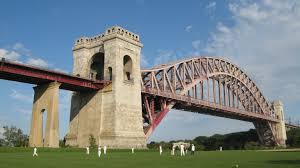Hell Gate Bridge (1916) is New York City’s oldest of its eight bridges. It was originally named after what the Dutch sailors called the narrow and treacherous river section that the bridge connects (Astoria, Queens and Ward’s Island). The Dutch are but one interesting perspective of this bridge. Also called the East River Arch bridge, one can be inside its cement towers looking out through an arch and feel as though you’re in an enclosed room with no notion of a river below you. Most interesting was the perspective taken into account on the final design of the bridge. Originally conceived as a full steel bridge with crisscrossed piers, it was seen by authorities as a potentially easy escape for criminals kept in the nearby correctional facility and for patients of the Ward’s Island Psychiatric Hospital. Therefore, the final design called for cement piers and towers that would make it difficult for individuals to climb.
Whose lens? What can Hell Gate Bridge teach us about partnerships?
For whom are you building the partnership? There are many lenses to look thru when considering a business partnership—your own and the partner’s, of course, plus your respective customers (external and internal), owners, shareholders, competitors and other existing partners.
Keeping the objectives for the partnership in mind will help you prioritize the various perspectives that need to be considered. Weighing the value of any partnership, as with all efforts, is best summarized as time, costs and quality. The challenge is that each partner’s time, costs and quality will likely be affected and valued differently. The solution is for the trade-offs to be seen as fair to achieving the respective objectives of each partner.
For example, if partners see the opportunity as revenue generating, then customers and prospects are priority lens #1. However, even if revenue is the top objective, but one partner brings technology enhancement to the agreement while the other partner contributes a strong client base, then there could be competing priority perspectives. Partnering when technology is the shared asset carries many perspectives that need to be considered, including legal rights and usage surrounding the intellectual property, engineering bandwidth to manage the technology transaction, and the end-user experience.
If the objective is for broader market reach and awareness, and the traded assets in the partnership have less direct impact on revenue enhancement, such as information, data or brand recognition, then the priority of the perspectives may include potential customers and, to a much lesser degree, the internal teams that must manage and deploy the new assets.
Note that not all stakeholders will be supportive of a new partnership. Presenting the business challenge with the partnership solution and distinguishing the objectives alongside the time, costs, and quality (estimated ROI), will help your stakeholders understand and hopefully support the plan.
Share a partnership that required you to look thru a different and perhaps difficult lens.
Part of a series: Causeways-business insight from the world’s most celebrated bridges
©2016, All rights reserved / www.karenwinston.com
To be clear, you do not have permission to take material from my blog and run it on yours.

